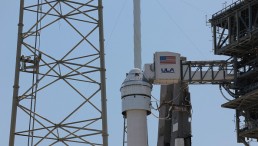Stargazers are in for a cosmic treat this weekend as the annual Eta Aquarids are set to peak.
Eta Aquarids 2024
The Eta Aquarids meteor shower typically runs from mid-April up until late May. It is set to peak at May 5 and May 6's early hours. There could be as many as 60 stars soaring per hour by this time.
Since the New Moon will be due on May 8, the Moon's glare will be almost fully absent during the Eta Aquarids meteor shower. This means that the conditions for viewing will be ideal by then.
Researchers who study the Eta Aquarids patterns over the decades have also discovered that for this year, notably higher activity could be exhibited. They suggest that the Eta Aquarids meteor shower 2024 could be the 21st century's most intense one.
A 2020 study notes that a model extension to future years predicts that there would be four notable outbursts of the Aquarids in 2023, 2024, 2045, and 2046.
It's time to #WatchTheSkies! 🔭
— NASA Marshall (@NASA_Marshall) April 30, 2024
The eta Aquariid meteor shower should put on a spectacular sky show from May 2-6, with meteor rates up to one per minute.
The next time the eta Aquariids will outburst is about 20 years from now. Don't miss it! >> https://t.co/yxx2u8paUD pic.twitter.com/PvzldyAWao
ALSO READ: What Is a Meteor Shower? NASA Explains Why There Are Periodic Streams Every Year
Eta Aquarids: an Annual Meteor Shower of Halley's Comet Debris
The Eta Aquarids meteor shower was named after the radiant of the shower. This radiant refers to the sky point where the meteors apparently come from. The meteor shower is close to the Eta Aquarii star belonging to the Aquarius constellation. It is among the several meteor showers that the Earth experiences each year.
The Eta Aquarids' meteors are known to have great speed. They move at a rate of 44 miles per second. These rocks typically leave an ionized gas trail that glows and lasts for a couple of seconds. At times, fireballs are also produced.
The meteors result from particles that a comet leaves behind during its solar orbit. As a comet nears a star, its surface ends up heating up. This causes debris, dust, and ice chunks to fall off during its wake. The debris trails form a dust band in the comet path, triggering a meteor shower as the Earth moves through this area each year.
The shower-causing particles are from Halley's Comet, or Comet 1P/Halley. This comet is quite known. It orbits the Sun roughly every 76 years. It is also responsible for the October Orionid meteor shower.
Brad Gibson, the director of the University of Hull's E.A. Milne Center for Astrophysics, says that, generally, the majority of comets shed dirt grains and dust bits, especially as they pass near the Sun during their orbits. The grains and dust largely follow the comet's same orbit. Hence, in most cases, it is easy to spot them. It is also predictable when the Earth moves through the debris. The yearly Eta Aquarids meteor shower happens because Earth moves through Halley's Comet's debris trail.
Halley's Comet spans roughly 10 miles across. The last time it passed near the Earth and within the inner solar system was in 1986. The next time it may swing by once more would be in 2061 yet. The comet orbits the Sun in a path that is highly elliptical. It takes roughly 76 years for it to finish one full trip.
Watch Eta Aquarids 2024
The best view of the meteor shower would be from the Southern Hemisphere. Observers from this area may get to witness up to 30 to 40 meteors soaring per hour in ideal conditions.
Across the Northern Hemisphere, lower rates could be observed. Stargazers may get to witness roughly 10 to 30 meteor soaring per hour. This is due to the lower position of the radiant in the sky.
In order to watch the shower, NASA recommends choosing an area that is far from street and urban lighting. The agency also recommends lying down with feet facing the east. After spending roughly 30 minutes in darkness, one's eyes could adjust to the view. This will make it quite easier to see the blazing meteors.
RELATED ARTICLE: Why Do We Study Comets? Understanding the Growing Relevance of Investigating Space Rocks in Unveiling the Cosmic Secrets
Check out more news and information on Space in Science Times.











![Mars Faces Three Times More Potentially Hazardous Asteroids Than Earth [Study]](https://1721181113.rsc.cdn77.org/data/thumbs/full/53711/258/146/50/40/mars-faces-three-times-more-potentially-hazardous-asteroids-than-earth-study.jpeg)



